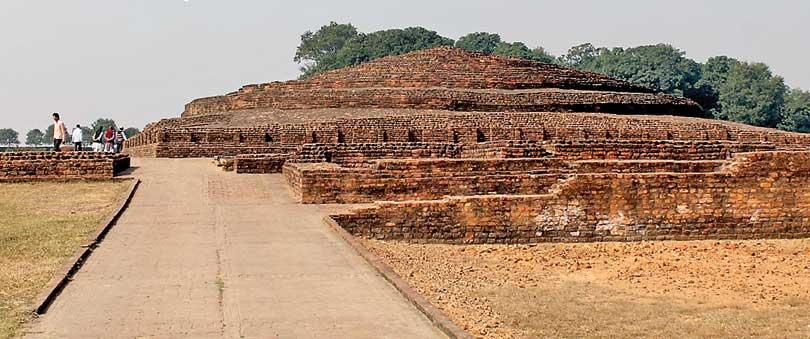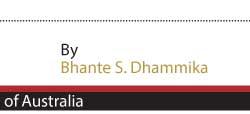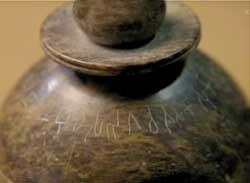Reply To:
Name - Reply Comment

 Paralleling the Himalayan foothills that define the modern India-Nepal border is a strip of terrain called the Terai. The whole region is flat and the soil is rich fertile alluvium. The numerous rivers and streams that flow down from the hills in the north sink into the gravel and then percolate to the surface in the Terai creating pools, bogs and swamps. For centuries most of the Terai was made up of thick malarial forest but beginning in the late 19th century it has been deforested and given over to rice cultivation. To get some idea of what the Terai was like before the clearing of the forest one has to visit the Katarniaghat and the Suhelva sanctuaries, Dudhwa National Park, or Valmiki National Park. Elephants, one-horned rhinoceros, the beautiful chital deer, tigers, wild buffalo and hyena roam through stands of sal and trees and areas of tall grasses. During the monsoon when the rain has washed the dust from the atmosphere the snowy peaks of the Himalayas can be clearly seen on the horizon to the north.
Paralleling the Himalayan foothills that define the modern India-Nepal border is a strip of terrain called the Terai. The whole region is flat and the soil is rich fertile alluvium. The numerous rivers and streams that flow down from the hills in the north sink into the gravel and then percolate to the surface in the Terai creating pools, bogs and swamps. For centuries most of the Terai was made up of thick malarial forest but beginning in the late 19th century it has been deforested and given over to rice cultivation. To get some idea of what the Terai was like before the clearing of the forest one has to visit the Katarniaghat and the Suhelva sanctuaries, Dudhwa National Park, or Valmiki National Park. Elephants, one-horned rhinoceros, the beautiful chital deer, tigers, wild buffalo and hyena roam through stands of sal and trees and areas of tall grasses. During the monsoon when the rain has washed the dust from the atmosphere the snowy peaks of the Himalayas can be clearly seen on the horizon to the north.
In the 5th century BCE, one of the ethnic groups who inhabited parts of the Terai were the Sakyans and it was into this group that the person who was to become the historical Buddha was born. Nothing in the early texts suggests that the Sakyan homeland was anything other than a small and unimportant chiefdom. Several ancient books make brief references to the Sakyans. The Mahavamsa and the Mahavastu give genealogical data include mentions of the Sakyans but these texts were composed centuries after the Buddha and thus may not be reliable. The Vishnu Purana includes a genealogical list for the Sakyans and mentions Suddhodhana, the Buddha’s father but not the Buddha himself. In several places in the Tipitaka 16 of the main states in the Middle Land are listed but Sakya is not amongst them. The Tipitaka also records the names of only ten population centres in the Sakyan country, again suggesting that it covered a modest area and probably that it was sparsely populated.
The Sakyans claimed to be descendants of the sons of the semi-mythical King Okkaka who had been driven into exile by the machinations of his second queen. Wandering through the forest they came to the hermitage of the sage Kapila who invited them to settle down nearby. Out of gratitude for Kapila, they named the settlement they established Kapilavatthu which later grew into the Sakyan’s principal town. Because this settlement happened to be in a grove of saka trees, the Indian teak, the exiles became known as Sakyans, at least that’s what Sakyan clan history said. In fact, the name Sakya is actually derived from ‘sak’ meaning to be able or capable. The Sakyans also claimed to be of the Adicca lineage, which supposedly went back to the Vedic sun god and to be of the warrior caste. Although nominally independent, the Sakyans were under the influence of the kingdom of Kosala, their larger and more powerful neighbour surrounding them on the south and west.
“The Sakyans are vassals of the king of Kosala, they offer him humble service and salutation, do his bidding and pay him homage.”
This explains why once the Buddha described his homeland as belonging to the king of Kosala and why the king of Kosala once said to the Buddha that the two of them were Kosalians. One text in the Tipitaka mentions the king being driven into Sakyan territory in his state carriage to the town of Medaḷumpa. It seems certain that he could only have done this because Sakya was subordinate to and a tributary of Kosala. Tradition says that towards the end of the Buddha’s life, the Sakyans’ de jure independence came to an end when their lands were formally absorbed into Kosala.
The Sakyan’s neighbours to their east were the Koliyans, the border between their territories being the Rohini River which has its source in the Himalayan foothills and flows into the Rapti River a little west of the modern town of Gorakhpur. A later although plausible legend from the Dhammapada commentary claims that the Sakyans and Koliyans nearly came to blows over  the use of the water in the river during a summer drought. The Tipitaka preserves only a few scraps of information about the Kolians; that the Buddha visited the chiefdom on several occasions, that they had a form of government similar to that of the Sakyans, and that they had a kind of police force which had a reputation for extortion and highhandedness. Later texts also claim that the Sakyans were related to and sometimes intermarried with the Kolians, which again seems quite plausible.
the use of the water in the river during a summer drought. The Tipitaka preserves only a few scraps of information about the Kolians; that the Buddha visited the chiefdom on several occasions, that they had a form of government similar to that of the Sakyans, and that they had a kind of police force which had a reputation for extortion and highhandedness. Later texts also claim that the Sakyans were related to and sometimes intermarried with the Kolians, which again seems quite plausible.
The Sakyans had a reputation for pride and impulsiveness and were considered rustics by their neighbours. A group of Sakyan youths are reported as saying of themselves: “We Sakyans are proud”, and Upali, himself a Sakyan described them as “a fierce people”.
Taking a more positive stance, the Buddha said his kinsmen were “endowed with wealth and energy”.
When the arrogant young Brahman Ambattha complained to the Buddha that during a visit to Kapilavatthu, the Sakyan youths did not give him due respect, the Buddha defended his kinsmen saying:
“But Ambattha, even the quail, such a little bird, can talk as she likes in her own nest.”
There are only a few scattered references to give us some idea of what Kapilavatthu, the Sakyan capital, was like. There was some kind of school there and a council hall (Santhagara) where the elders of the clan would meet to discuss matters pertaining to the running of the chiefdom. After the construction of a new council hall, the Buddha was invited to inaugurate it by spending the night in it. Within walking distance from Kapilavatthu was the Nigrodharama, a park where the Buddha would stay during his occasional visits. From there he could walk to the Mahavana, the Great Forest, indicating that the town was surrounded, at least on some sides by extensive forests.
Two other references in the Tipitaka give an idea of the extent of the Sakyan capital. In one place Kapilavatthu is called a village (gama) and in another, a Sakyan elder described it as being “rich, prosperous, full of people, crowded and thickly populated” which seems to be describing something bigger than a mere village. Archaeology can help resolve the apparent disparity between these two descriptions. In the 1980s archaeologists did an extensive survey of ancient settlement sites in the Kanpur district of Utter Pradesh dating from between the 7th to the 3rd century BCE.
They found that of 99 sites 41 covered an area of less than one hectare and 40 between one and two hectares. Thus as many as 81 settlements were less than two hectares and it was calculated that these could have had a population of not more than 500 people. There were 14 settlements covering an area of between two and four hectares and these could have had a population of between 500 and 1000.
We have no idea what religion prevailed amongst the Sakyans and thus might have influenced the young Gotama. There is no mention of any Brahman priests residing in the Sakyan country
Four settlements were more than four hectares and could have accommodated between 1,200 and 1,300. All these population centres were much smaller than the main cities of the time and they would qualify as villages today.
If Kapilavatthu had a population of 1,300 it would have been big enough to be described as bustling and crowded, especially if it was also a centre of commerce and the seat of government. Excavations conducted at Kapilavatthu itself in the early 1970s confirm the impression that it was a modest place even by the standards of the time. They revealed that the area it took up was small, although the whole area could not be explored because much of it was under agriculture. All structures had mud walls and the only ones made of backed brick dated from well after the Buddha’s time. Kapilavatthu was nothing like the grand royal capital as described in later Buddhist legend.
Today the site of Kapilavatthu is contested between India and Nepal.
The Nepalese say it is in their territory at Tilaurakot while the Indians claim it is in their territory at Piprahwa. All the archaeological evidence points to the Indian claim being correct. Seals mentioning the name Kapilavatthu have been excavated at Piprahawa as well as a relic casket mentioning the Sakyans. This second inscription is amongst the oldest decipherable writings ever found in India.
It has often been said that the Buddha came from a Hindu family, a claim that seems to be based on the assumption that because most Indians today are Hindus they must have been in ancient times too. In reality, we have no idea what religion prevailed amongst the Sakyans and thus might have influenced the young Gotama. There is no mention of any Brahman priests residing in the Sakyan country and the only one mentioned as having visited Kapilavatthu was given none of the respect such people took to be their due. Vedic Brahmanism, the precursor of Hinduism, had been moving from its traditional sacred land in Punjab into the Ganges Valley for at least 200 years was in the process of establishing itself in the main Magadha were kings such as Bimbasara of Magadha had taken Brahmans as court advisors and functionaries. On the other hand, one of the king’s cousins had become an Ajivaka, one of the heterodox sects of the time suggesting that the new religions had a following amongst the elite. But peoples such as the Sakyans, on the fringes of the major states, were still probably uninfluenced by Brahmanism.
And in at least some quarters Brahmanism was being resisted. This is probably why throughout the Tipitaka the warrior caste is always considered superior to the Brahman caste.
It seems that the clan-based chiefdoms were still resisting the Brahman concept of caste hierarchy. The only hint we have of the religious life of the Sakyans is the brief comment that Vappa, the Buddha’s uncle, was a follower of Jainism, again another heterodox sect. The majority of Sakyans, indeed most people throughout the Middle Land during the Buddha’s time, were probably what we would now be called animists, worshipping their own local spirits and gods.
We have some information on the political life of the Sakyans. Legend claims that the Buddha’s father Suddhodana was a king although there is scant evidence in the Tipitaka to back up this claim. Nowhere is the Buddha called a prince (raja kumara), nowhere is he or his family said to live in a palace, and only once is his father called raja, a word usually translated as king. Although by the 5th century the word had come to mean a king it still retained its earlier meaning of an elected chief without any regal connotations. Even in the very places where one would expect the Buddha to call his father a king or himself a prince he did not do so. For example, when asked by King Bimbisara about his family and birth, the Buddha simply replied that he was from a Sakyan family.
The Tipitaka mentions that the Sakyans had a body of men called rajakattaro, ‘chief-makers’. Such groups are mentioned in other early Indian texts and it is clear that they elected chiefs to rule over them, either for a set period or for as long as he had their confidence. The council hall the Buddha had inaugurated in Kapilavatthu, was the very kind of place where the chief-makers and clan elders would have gathered to conduct business and the chief preside over their meetings as the first among equals.
Thus we can say that while the Buddha was almost certainly from a patrician or ruling class family, he was not royalty in the sense that is understood today. It is also worth noting that Suddhodana gets only three brief references in the Tipitaka. The only person who is mentioned as being a Sakyan chief other than Suddhodana is Bhaddiya, at VinayaII,180-182. After he became a monk he mentioned that when he was chief he lived in constant anxiety and had to have guards in his residence and in the town for his security. This suggests that Sakyan politics could sometimes get nasty.
Of course, later tradition and popular legends have much more to say about the Sakyans and Kapilavatthu but what has been given here is everything the Pali Tipitaka, the oldest and most authentic record of Buddhism says about these people and their capital.